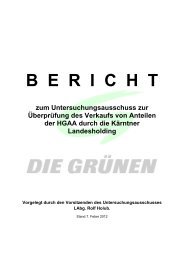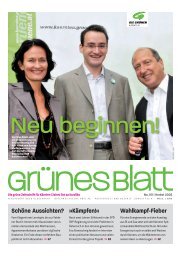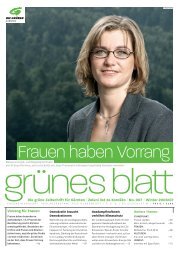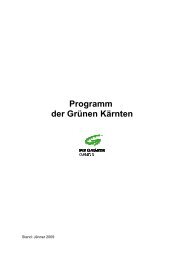MUSTER3 Stellungnahme (PDF)
MUSTER3 Stellungnahme (PDF)
MUSTER3 Stellungnahme (PDF)
Create successful ePaper yourself
Turn your PDF publications into a flip-book with our unique Google optimized e-Paper software.
Absender:<br />
An das<br />
Amt der Kärntner Landesregierung<br />
Abteilung 8<br />
Flatschacherstr. 70<br />
9020 Klagenfurt/Celovec<br />
Betreff: <strong>Stellungnahme</strong> zum Entwurf der Slowenischen Energiestrategie 2011 (NEP)<br />
Sehr geehrte Damen und Herren,<br />
……………….……, am ………………..<br />
Ich bitte um Übermittlung meiner anschließenden <strong>Stellungnahme</strong> zur strategischen Umweltprüfung des<br />
nationalen Energieprogramms der Republik Slowenien an die zuständigen Behörden in Slowenien im<br />
Wege des Bundesministeriums für Land- und Forstwirtschaft, Umwelt und Wasserwirtschaft. Zudem<br />
ersuche ich um persönliche Information über die weiteren bilateralen Verhandlungsergebnisse zum<br />
gegenständlichen Dokument.<br />
<strong>Stellungnahme</strong> – deutsche Fassung:<br />
Zum Entwurf der Slowenischen Energiestrategie 2011 (NEP) nehme ich wie folgt Stellung:<br />
� Ad Europäische Strategie 20:20:20:<br />
Obwohl die Ziele der EU-Strategie 20:20:20 als Grund zur Adaptierung der nationalen Energiestrategie<br />
angeführt sind fehlt die detaillierte Darstellung einer slowenischen Strategie zur Erreichung dieser Ziele.<br />
� Ad Energieeffizienz:<br />
o Die meisten der angeführten Ideen im Sub-Programm Energieeffizienz sind nicht finanziert und<br />
es fehlt die Darstellung konkreter Maßnahmen, Umsetzungszeiträume wie auch der<br />
hauptsächlich zu involvierenden Institutionen.<br />
o Obwohl das NEP engagierte Ziele zur Reduktion des Energiekonsums setzt, beinhaltet der Plan<br />
zusätzliche fossile und nukleare Kraftwerke mit einer Kapazität von 1800 MW (2020) und<br />
weiteren 1800 MW (2030) 1<br />
o Diese Projekte sind nicht notwendig für die nationale Energieversorgung, wie aus dem Vergleich<br />
der Szenarien 2020 und 2030 ersichtlich ist 2 – tatsächlich würde Slowenien durch den Bau<br />
weiterer umweltbelastender Kraftwerke zu einem stromexportierenden Staat werden!<br />
o Diese Tatsache wird untermauert durch die Pläne des NEP zum Ausbau der<br />
Hochspannungsleitungen nach Italien und Ungarn 3 .<br />
� Erneuerbare Energien:<br />
o Obwohl fixe Ziele für den Anteil Erneuerbarer Energien<br />
Response to the National Energy Program (NEP) of the Republic of Slovenia page 1<br />
4 beinhaltet sind, umfassen die geplanten<br />
Kapazitäten im Bereich Erneuerbare Energien nur rd. 1/3 der geplanten neuen Kapazitäten<br />
fossilen/atomaren Sektor 5 . Damit können die Ziele im Bereich des Anteils erneuerbarer<br />
Energien in der Stromproduktion (40 % 2020, 54 % 2030) nicht erreicht werden.<br />
o Die Maßnahmen und Umsetzungszeiträume für die Projekte im Bereich der Erneuerbaren<br />
Energien 6 sind unkonkret und nicht kalkuliert. Selbst für die kalkulierten Maßnahmen fehlen lt.
Darstellung der Finanzierbarkeit rund 50 % der notwendigen Fördermittel 7 .<br />
� Atomenergie:<br />
Das Atomenergie-Sub-Programm definiert die Laufzeitverlängerung des AKW Krško und ein neues<br />
AKW mit der Argumentation einer sicheren, langfristig stabilen und CO2-armen Energieversorgung 8 . Ich<br />
protestieren schärfstens dagegen, denn:<br />
o Diese AKW-Projekte sind nicht notwendig für die nationale Energieversorgung<br />
o Die Gefahren eines Unfalls mit Freisetzung von Radioaktivität sind nie zu gänzlich auszuschließen.<br />
Die nuklearen Ausbaupläne sind daher abzulehnen, insbesondere in Anbetracht der Tatsache,<br />
dass:<br />
� das AKW Krško nahe der österreichischen Grenze liegt. Die Auswirkungen eines Unfalls im<br />
AKW Krško können also auch die österreichische Bevölkerung treffen.<br />
� das AKW Krško in einer erdbebengefährdeten Zone liegt. Die Laufzeitverlängerungs- und<br />
Neubaupläne des AKW Krško stellen daher ein außergewöhnlich hohes Risiko für die<br />
österreichische Bevölkerung dar.<br />
� im Falle eines Unfalls keine vom slowenischen Staat garantierte Haftung für Auswirkungen<br />
in Österreich besteht.<br />
o Die nationale Ökonomie Sloweniens ist zu klein, um die möglichen Kosten eines Unfalls im AKW<br />
Krško zu decken. Niemand kann deterministisch beweisen, dass ein derartiger Unfall<br />
auszuschließen ist, das sogenannte “Restrisiko” bleibt ein Risiko mit enormen Kosten. Eine aktuelle<br />
Studie des Versicherungsforum Leipzig 9 beziffert die Kosten für einen schweren nuklearen Unfall<br />
auf € 6 Billionen. Diese Summe kann weder der Betreiber, noch der Staat Slowenien aufbringen.<br />
In einem kleinen Land wie Slowenien würde jeder schwere Unfall in einem AKW negative<br />
Auswirkungen auf große Teile des Landes und grenzüberschreitend verursachen.<br />
Mit der ungeschriebene europäische Solidarität für die Bewältigung der Kosten eines solchen<br />
Unfalls kann Slowenien nicht rechnen, weil den politischen Entscheidungsträgern dieses Restrisiko<br />
zum Zeitpunkt ihrer Entscheidung bekannt war. Dies sollten Sie daher bei der Entscheidung über<br />
diese Energietrategie, insbesondere über die Laufzeitverlängerung des AKW Krško und die<br />
Errichtung eines Generation 4 – Reaktors in Slowenien, nicht außer Acht lassen.<br />
o Die NEP beinhaltet kein finanziell und in zeitlich realisierbares, belastbares Projekt für die<br />
Endlagerung des radioaktiven Abfalls aus dem AKW Krško. Die Finanzierung der Errichtung und<br />
einer langfristigen Überwachung eines Endlagers ist im NEP nicht definiert.<br />
o Der NEP sieht “Generation 4” Reaktoren für das neue AKW vor. Es existieren aber keine<br />
Kostenkalkulationen für neue Atomkraftwerke – insbesondere für Generation 4 Reaktoren. Daher ist<br />
es unzulässig Generation 4 Reaktoren in diesem Strategiepapier zu berücksichtigen, da die<br />
fundamentale Basis für eine politische Entscheidung nicht existiert. Generation 4 Reaktoren sind<br />
hauptsächlich Schnelle Brüter, für welche die nötige Infrastruktur weder in Slowenien, noch sonstwo<br />
in der EU besteht. Insofern ist dieser Strategieteil höchst spekulativ und für eine politische<br />
Entscheidung zu unausgereift.<br />
o Die Definition von Atomstrom als “CO2-armen Energieversorgung” ist als wissenschaftlich falsch<br />
anzusehen – wie beispielsweise eine Studie des “Ökologieinstitut Darmstadt” zeigt, liegen die CO2<br />
Emissionen von Atomstrom bei Berücksichtigung des Lebenszyklus von Uran (Abbau bis<br />
Endlagerung) zwischen 32 und 126 g/kWhel und sind damit vergleichbar mit neuen, effizienten<br />
Gaskraftwerken.<br />
Deshalb bezweifle ich sehr, dass Slowenien in der Lage ist, weiterhin auf die Nutzung von Kernenergie zu<br />
bauen, da es die Kosten eines – deterministisch nicht auszuschließenden – schweren Unfalls im AKW<br />
Krsko nicht decken kann.<br />
Für den Fall, dass sich das slowenische Parlament für die weitere Nutzung der Atomkraft entscheidet,<br />
fordere ich entschieden, dass die Republik Slowenien die Kosten potentieller negativer grenzüberschreitenden<br />
Auswirkungen eines möglichen Unfalls übernimmt und dies im Rahmen eines bilateralen<br />
Vertrages mit Österreich verbindlich zusichert. Dies hat auch durch eine Revision des slowenischen<br />
Nuklearhaftungs-Abkommens zu erfolgen, so dass der Betreiber für sämtliche Kosten in und außerhalb<br />
Sloweniens haftet. Ein solches überarbeitetes Haftungsregime hat die Verpflichtung des AKW-Betreibers<br />
zur Internalisierung der Risikokosten durch die Einberechnung in seine Verkaufspreise für Elektrizität<br />
einzuführen. Diesbezüglich beziehe ich mich auf die kürzlich veröffentlichte Studie des Versicherungsforums<br />
Leipzig, das die Versicherungskosten mit € 0,14/kWh to € 2,36/kWh beziffert 9 .<br />
Response to the National Energy Program (NEP) of the Republic of Slovenia page 2
Aus den oben angeführten Gründen lehne ich das Nationale Energieprogramm der Republik Slowenien ab<br />
und fordere eine Überarbeitung und die Behebung der von mir angeführten Mängel.<br />
Response to the National Energy Program (NEP)<br />
� European strategy 20:20:20:<br />
Although the gains of the European Strategy 20:20:20 is mentioned as one of the reasons to adopt the<br />
NEP, a detailed description of the strategy for reaching this goals is missing.<br />
� Efficiency:<br />
o There are many ideas for the EUE-sub-program, but most of them are not financed and the<br />
description of the concrete measures and the time-limits are missing.<br />
o Although the NEP (page 31) sets ambitious objectives for the long-term reduction of final energy<br />
consumption without transport (a reduction of final energy consumption by 7% from 2008 to<br />
2030), the plan includes additional production of fossil and nuclear energies of about 1.800 MW<br />
(2020) and further 1.800 MW (2030) 1 .<br />
o As you see in the comparison of scenarios in 2020 and 2030 2 these projects, are not necessary<br />
for the national energy-supply – in fact Slovenia would become an electricity-exporting country<br />
by building further, non ecological power plants!<br />
o This fact is stressed by the NEP-strategies plans for building new high-voltage grid connections<br />
to Italy and Hungary 3<br />
� Renewable Energies:<br />
o Although there are fixed gains 4 for the shares of RES in the energy mix, the planned new<br />
capacities are less than a third of the planned fossil/nuclear capacities 5 . The gain of increasing<br />
RES-shares on the electricity-market (40 % 2020 and 53 % 2030) are in doubt to be reached by<br />
this strategy.<br />
o The tasks and time-limits for the RES-sub-program 6 are very unconcrete. The financing of most<br />
projects is not calculated. Also for the calculated projects about 1/2 of the needed funds are still<br />
“missing” 7<br />
� Nuclear energy:<br />
The nuclear energy sub-program defines the projects of life-time-extension for the NPP Krško and a<br />
new NPP 8 - with the explanatory statement of a secure, long-term stable and low-carbon supply of<br />
electricity. I strictly protest against this projects because:<br />
o The NPP-projects are not necessary for the national energy supply (see efficiency)<br />
o The risks of an accident with disposals of radioactivity in an NPP can never be completely<br />
excluded. I decline those nuclear extension-plans are due to the facts that:<br />
� the location of the NPP Krško is next to the Austrian border. The negative effects of an<br />
accident in the NPP Krško can also harm Austrian citizens like me.<br />
� the location of the NPP Krško is settled in an earthquake-prone area. The life-timeextension<br />
and new NPP-building plans for Krško are an extra-ordinary risk for accidents<br />
with cross-border effects to Austria.<br />
� in case of an accident there is no guaranteed liability by the Republic of Slovenia to<br />
cover damage-costs in Austria.<br />
o The national economy of Slovenia is too small to cover the possible costs of damages of an<br />
accident at NPP Krško. Nobody is able to proof that such accidents cannot happen on a<br />
deterministic basis. The so-called “Restrisiko” will still remain – a risk with enormous costs.<br />
A recent published study of the “Versicherungsforum Leipzig”, defines a insured sum of about<br />
€ 6 billion for each NPP 9 . Neither the operator nor the State of Slovenia will be able to cover the<br />
extraordinary high costs.<br />
Under the conditions of such a small country like Slovenia any severe accident at a nuclear<br />
power plant will result in negative effects on large parts of Slovenia and abroad. Slovenia cannot<br />
rely on the unwritten European solidarity in the case to cope with the negative effects of such an<br />
accident, because the politician decision-makers have known the risk they imposed by their<br />
decision. The politicians, who will decide on this strategic document, especially on the long term<br />
operation of NPP Krško and projects which aim to construct a Gen4 reactor in Slovenia, should<br />
not disregard this fact.<br />
o The NEP does not include monetary and temporally verified projects for final disposal of high<br />
radioactive waste of the NPP in Krško. The financing funds for building and long-time-monitoring<br />
of a final disposal are not defined by the NEP.<br />
Response to the National Energy Program (NEP) of the Republic of Slovenia page 3
o The NEP plans schedules a “Generation 4” reactor for the new NPP. Cost assumption of new<br />
NPP´s – especially Gen4 reactors do not even exist – It is therefore not recommended to<br />
include Gen4 reactors in this strategy paper, as the fundamental basis for a political decision<br />
does not exist. Gen4 reactors are mainly breeder reactors, for which the necessary<br />
infrastructure doesn’t exist in Slovenia or any other European State. In this respect the NEP is<br />
very speculative and not enough developed for a political decision.<br />
o The definition of nuclear energy as a “low-carbon supply of electricity” is to be seen as sciencebased<br />
wrong – as a study of “Ökologieinstitut Darmstadt” shows, the CO2emissions of nuclear<br />
energy including the lifetime of uranium (mining to storage) are calculated between 32 and 126<br />
g/kWhel, what’s comparative with new and effective thermal gas-power plants.<br />
Therefore I strongly doubt, that Slovenia is in the position to prolong the utilization of nuclear energy, as it is<br />
and will be unable to cover the damage costs arising from a not deterministic excludeable severe accident<br />
at the NPP Krsko.<br />
But in case that the sovereign decision of the Parliament of Slovenia will be to continue the utilization of<br />
nuclear energy I strongly demand, that the Republic of Slovenia will declare to cover the costs of the cross<br />
border negative effect of an possible accident. This has also to be assured by the revision of the Slovene<br />
nuclear liability acts, so that the operator will have to be liable for all costs arising in and outside of<br />
Slovenia. Such a revised nuclear liability act, will have to impose the duty on the nuclear power plant<br />
operator to internalize these costs into the selling price of electricity. With respect to this aspect, I refer to<br />
the findings of the recent published study of the “Versicherungsforen Leipzig”, that defines insurance costs<br />
between € 0,14/kWh to € 2,36/kWh 9 .<br />
For the above mentioned reasons I decline the NEP of the Republic of Slovenia in this version and require<br />
a revision of the program and the corrections of the defects, listed in my response.<br />
Signed: ………………………………………………………..<br />
Response to the National Energy Program (NEP) of the Republic of Slovenia page 4
1 (page 85 NEP) Table 26 & 27: The expected response of actors to the measures of the sub-programme Electricity Generation<br />
and market conditions – investment projects by 2020 / 2030<br />
2 (page 152 NEP): electricity-export 2008: - 1,4 TWh, Scenarios 2020: + 1,5 to + 2,1 TWh, Scenarios 2030: +2,6 to +10,2 TWh<br />
3 (page 88 NEP) construction and reinforcement of internal connections at the highest voltage level of 400 kV:<br />
* by concluding the internal 400 kV loop by overhead power line between TS Beričevo and TS Krško, and transition of the inner 200<br />
kV network to 400 kV voltage level;<br />
*connection with neighbouring countries by constructing new cross-border European connections: with a new 400 kV connection<br />
with Hungary by 2016 and a new connection with Italy by 2018, and for bringing the markets closer, regional connection and<br />
strengthening of the internal European electricity market;<br />
4 (page 31 NEP) Renewable energy sources: The objective is to exploit, as a priority, all environmentally suitable RES to achieve a<br />
long-term increase and attain the target share of RES in the gross final energy consumption, namely: heat ‒ a 33% share by 2020<br />
and a 37% share by 2030; electricity – 40% by 2020 and a 53% share by 2030.<br />
5<br />
RES (page 63/64)Table 13: Expected response of the actors to the incentives of the Renewable energy sources sub-programme<br />
and market development:<br />
545 MW 2020 / 926 MW 2030 + not defined heating systems utilizing RES about 50 % not financed (Table 14: Funds required for<br />
implementing the RES sub-programme and financing sources)<br />
6 Table 12: Tasks, time limits, responsible institution and financial resources of the Renewable energy<br />
sources sub-programme: resources for implementation of OP ETID – incentives for RES for 2011-2015: 63,8 Mio<br />
implementation of AP RES measures 2020 898.13<br />
promotion of constructing active buildings 15,8 mio<br />
7 Table 14: Funds required for implementing the RES sub-programme and financing sources<br />
“missing funds” (mio €) 2010: -23.5 (of 70,5), 2011: -46.5 (of 96,6), 2012 -49.1 (of 101,8), 2013: -49.8 (of 109,1) ..<br />
8 (NEP page 117)nuclear: Sub-programme objectives<br />
The sub-programme objectives are to contribute to a secure, long-term stable and low-carbon<br />
supply of electricity with the emphasis on:<br />
• further safe operation of nuclear facilities in Slovenia;<br />
• permanent and safe disposal of low- and intermediate-level waste (LILW) and preparation<br />
of a proposal of the resolution concerning decomposition and management of high-level<br />
waste (HLW);<br />
• extension of the projected operational life of Nuclear Power Plant Krško (NPPK);<br />
• further long-term exploitation of nuclear energy in Slovenia through construction of a new<br />
nuclear power plant;<br />
• high-quality expert and research activities in the nuclear energy sector<br />
9<br />
Versicherungsforen Leipzig, Studie zur Berechnung einer risikoadäquaten Versicherungsprämie zur Deckung der<br />
Haftpflichtrisiken, die aus dem Betrieb von Kernkraftwerken resultieren<br />
http://www.bee-ev.de/_downloads/publikationen/studien/2011/110511_BEE-Studie_Versicherungsforen_KKW.pdf<br />
Response to the National Energy Program (NEP) of the Republic of Slovenia page 5







